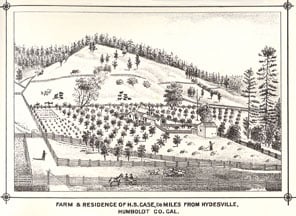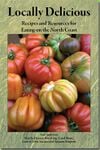European settlers arrived in the early 1850s and found good land for crops and livestock. Three early reports verify the abundance and variety of the foods produced in the 19th century.
Table 4.1 Agriculture in Humboldt County in the 19th Century
| Product | '1860'[1] | '1880'[1] | 1891'[2] | 1890 | ||
|---|---|---|---|---|---|---|
| Acres | Bushels | Acres | Bushels | Acres | Bushels | |
| Wheat | 1,564 | 40,564 | 3,705 | 86,600 | 1,504 | 350,000[3] 34,587[2] |
| Barley | 58 | 1,991 | 3,289 | 54,418 | 2,244 | 250,000[3] 103,221[2] |
| Oats | 542 | 15,723 | 7,193 | 260,774 | 7,805 | 600,000 [3] 351,234 [2] |
| Corn | 63 | 1,990 | 364 | 10,223 | 572 | 100,000[3] |
| Peas | 883 | 31,584 | 656 | 17,321 | 776 | 38,413[2] |
| Potatoes | 744 | 56,632 | 1,706 | 9,428,000 | 1,434 | 221,934[2] |
| Butter in pounds | 34,400 | 96,750 | Estimated
2,023,720 [2] | |||
| Cheese in pounds | 6,800 | 1,400 | n. a. | |||
| Apple trees | 15,888 | 10,457 | n. a. | |||
| Peach trees | 2,330 | 2,550 | n. a. | |||
| Pear trees | 567 | 927 | n. a. | |||
| Plum trees | 508 | 1,223 | n. a. | |||
| Horned cattle | 19,205 | 26,623 | n. a. | |||
| Cows | n. a. | n. a | 13,638³ | |||
| Cattle* | n. a | n. a | 18,822[2] | |||
| Sheep | 523 | 170,829 | 93,104³ | |||
| Goats | 18 | 372 | 142³ | |||
| Hogs | 8,194 | 7,267 | 5,304[2] | |||
- Stock cattle, beef cattle and calves
By 1881, Humboldt County was exporting potatoes, oats, wheat, peas, wool, barley, apples, cowhide, bacon, pork, lard, tallow, butter, leather, beef, fish, salmon, tanbark, charcoal and flax seed. In 1881, Humboldt County exported more than 21 million pounds total. In addition, the county exported poultry, eggs, horses, calves, sheep, hogs, pelts, skins, furs and many lumber products, the largest exports being wood products, potatoes, oats, wheat, peas, wool and butter.[1]

By 1892, there were 26 creameries. A salmon cannery was located at the mouth of the Eel River, and Fortuna had a fruit cannery.
The Fortuna fruit cannery was started in 1892 and by 1893, canned 25,000 cans of strawberries, prunes, plums, cherries, raspberries, currants, gooseberries, wild blackberries, huckleberries, pears and “pie fruits.” The Humboldt Chamber of Commerce reported the fruit cannery “ . . . has been of inestimable benefit to the surrounding country in stimulating fruit production, especially berries and small fruits for which the soil and climate of Humboldt are particularly adapted.” In one season, this cannery established a reputation for excellence of its product and easily contracted the whole output for 1893 at profitable figures.[2]
By 1913, we have the following reports:
It should not be forgotten that one of the greatest apple experts in the world, George E. Rowe, vice-president of the American Pomological Society, has declared that Humboldt county contains some of the best apple-growing lands on the face of the earth.[4]
Albert E. Etter, Humboldt County’s famous plant breeder and strawberry grower, predicts great things for the small fruits and berries. He sees many spots which are capable of being transformed into veritable gardens of Eden, this without any fear of frost or pests.[4]
By 1927 Humboldt County farmers were winning numerous awards at the California State Fair. Seven first prizes for apples, four for varieties of wheat, two for barley and three for oats. Sorghum and maize also won first prizes. Four varieties of beans, crisp head lettuce, Swiss chard, sweet corn, spinach and three varieties of potatoes also took first-place awards. Many gold medals and third awards were also won in a large number of categories.[5] From 1951, Humboldt County’s records show that agricultural output has been dominated by livestock and dairy products. Livestock and dairy products, which accounted for more than 90 percent of the dollar value in 1951, now account for more than 80 percent. Fruit, vegetable and grain crops have been a small proportion of the economic value of our agriculture since 1950. They peaked in the 1970s, reaching nearly ten percent, largely due to the success of the potato crops. Since then, fruit, grain and vegetable crops have represented about two to four percent of the economic value of agriculture in Humboldt.
| Potatoes were once a major export crop of Humboldt County. An article in the Times-Standard, May 9, 1971,[6] reports: Old files of the Humboldt Times from the 1860s through the 1890s indicate
the potato industry was a major item. However, the battle with plant diseases was never successful, and growers gave up until recent years, when science rescued the crop. The article further reports: The potato crop from this area is highly desirable for potato chips, because of their excellent quality. The major buyers are Granny Goose, Laura Scudder and Eagle Foods. At the peak, farmers were converting dairy land to potato fields at Grizzly Bluff, Pleasant Point, Waddington Island, the Loleta Bottoms, Blue Lake and Carlotta areas.[6] The Acreage may have exceeded 2,500 producing over 30,000 tons of potatoes. |
A few other trends may be noted. In the 1950s through 1970s, Humboldt County produced a large volume of chickens, ducks, pigeons, geese and turkeys. In 1951, the county produced 832,149 dozen eggs. That’s almost ten million eggs! But production of eggs or poultry for meat is not currently significant. Hog production in 1951 was almost 5,000 animals. The last figure available for hogs is 200, in 1995. Sheep and lamb production was at 90,000 head in 1951, down to 3,370 in 2007.[7] Grain, once an important crop in our region, has economic importance since the 1980s only for animal feed.
| The Humboldt Standard reported: Large producers of turkeys were located in McKinleyville, Glendale, Hoopa and Blue Lake. The turkey count was 1,600 in 1941[8] and more than 2,100 by 1950.
Humboldt County produced over 370,000 pounds of chicken in that same year.[9] |
Some parts of our agriculture may have declined, but this brief review demonstrates that local self-sufficiency is indeed possible.
References[edit | edit source]
- ↑ 1.0 1.1 1.2 History of Humboldt County; California. Wallace W. Elliott and Co., San Francisco CA, 1881.
- ↑ 2.0 2.1 2.2 2.3 2.4 2.5 2.6 2.7 2.8 2.9 Eddy, J. M. In the Redwood’s Realm; By-ways of Wild Nature and Highways of Industry as Found Under Forest Shades and Amidst Clover Blossoms in Humboldt County, California. Humboldt Chamber of Commerce, 1893. Available in the Cal Poly Humboldt library
- ↑ 3.0 3.1 3.2 3.3 History and Business Directory of Humboldt County; http://bood.google.com
- ↑ 4.0 4.1 California Genealogy and History Archives, http://www6.calarchives4u.com/
- ↑ The Times, “Humboldt County Captures Many Awards at State Fair,” 1927
- ↑ 6.0 6.1 The Times Standard, “Humboldt Potato Farming Booms After Bad Weather,” May 9, 1971
- ↑ Annual Crop Reports
- ↑ The Times. “Humboldt Turkey Trot…March on Thanksgiving,” November 12, 1941
- ↑ Department of Agriculture, Humboldt County, Annual Crop Reports to the County Board of Supervisors, 1951-2008.
